Terry chubushnik: varieties, selection, cultivation and reproduction
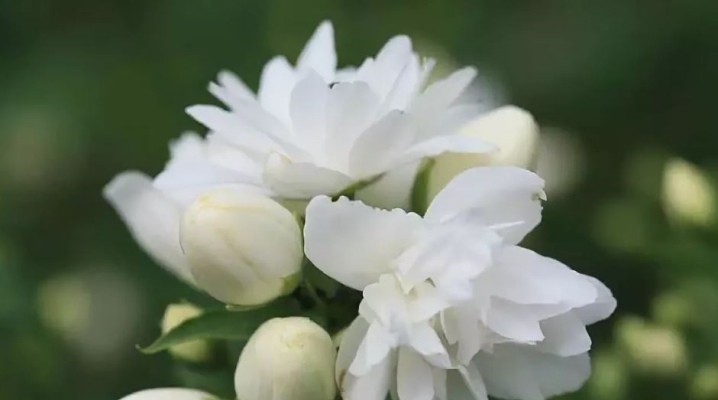
Terry chubushnik or garden jasmine is one of the most popular shrubs cultivated in central Russia. In addition to a pleasant aroma and a violent, lush flowering, this plant is distinguished by its unpretentiousness and ease of reproduction. Terry varieties of garden jasmine look even more decorative because of the special arrangement of the petals - there are much more of them than in the natural species. Lush rosettes look especially elegant against the background of green foliage. With this addition, the landscape always looks especially elegant, expressive and acquires a unique appearance.
How do you plant and care for shrubs outdoors? How to propagate garden jasmine by cuttings, what growing conditions does it need? All these issues require careful consideration, because improper cultivation can destroy the shrub. Consider what is worth considering when choosing garden jasmine for planting.
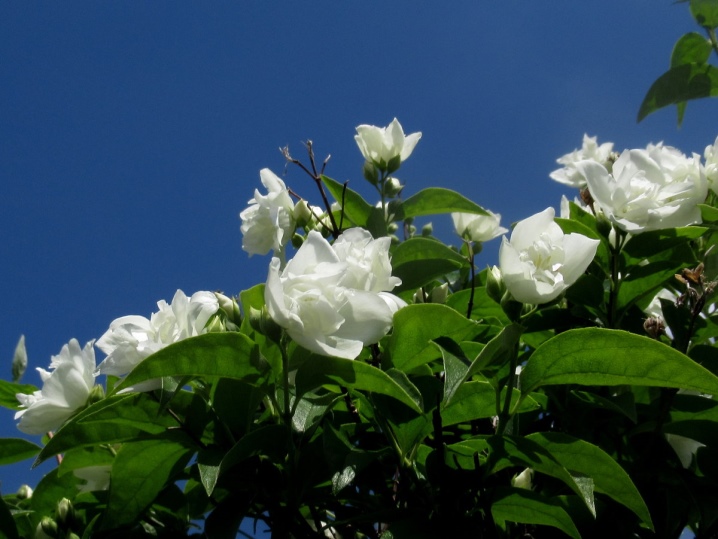
Characteristic
The horticultural crop, known as terry chubushnik, is a perennial shrub plant belonging to the hydrangea family. Only a bright aroma makes it related to classic jasmine. The description emphasizes the difference between these shrubs. In nature, the mock-orange looks more modest; it grows naturally in the countries of North America, Europe and Asia. Breeding varieties are usually double or semi-double.
The size of the chubushnik bush in ordinary forms does not exceed 3 m, dwarf ones grow no more than 1 m in height. The crown of the plant is rather spreading, sometimes weeping, drooping under the weight of inflorescences collected in a brush. The diameter of the bush can also reach 2-3 m. For shoots 1 year old, a gray bark is characteristic, from 2 years old it often turns brown, stiffens, a soft core remains inside.

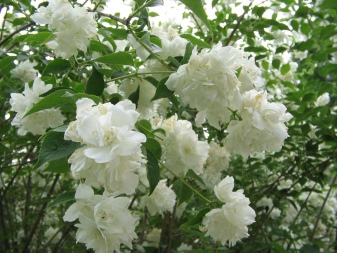
Garden jasmine is a product of selective breeding, obtained in France in 1909. The originator by the name of Lemoine, the owner of his own nursery, bred this culture by crossing different types of common mock-orange. The first terry variety was "Virgin". Today its popularity has not diminished in the least.
Lemoine's nursery has long been a trendsetter in the cultivation of garden mockweed. The Russian breeder Vekhov competed with him in the first half of the 20th century.
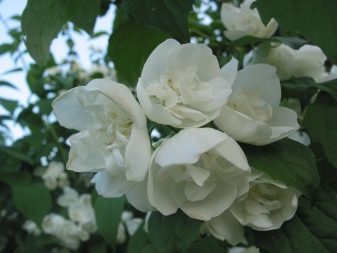
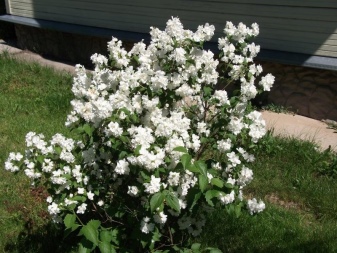
Abundant flowering is characteristic of the terry mock-orange. Depending on the variety, the splendor of the buds and the number of petals in them vary. Flowering begins in the 3rd decade of June and lasts from 14 to 21 days. Terry types do not differ in the strength and sharpness of the aromatic composition, it is more delicate and refined.
For abundant flowering, the correct choice of planting site is required - the shrub will delight with splendor only in a well-lit place.
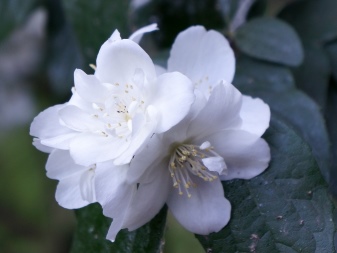

Varieties
Terry chubushnik has a large varietal variety. It is characterized by a white, pale cream or yellowish color of the flower, sometimes at the base of the petals have a pink tint. A selective shrub, not as fragrant, but no less beautiful than its wild-growing variety. Several varieties can be distinguished among the most popular planting options.
- Alabastrite or "Alabastrite". A snow-white variety of French selection, obtained as a result of crossing hybrids of ordinary, small-leaved and large-flowered chubushniks.The bush grows up to 1.8 m, the shoots are strong, erect. Inflorescences are semi-double, form brushes of 7-9 buds up to 11 cm long.The diameter of a blossoming flower reaches 5.5 cm.
It is a highly aromatic variety that blooms for up to 36 days and forms buds a little later than classic jasmine.
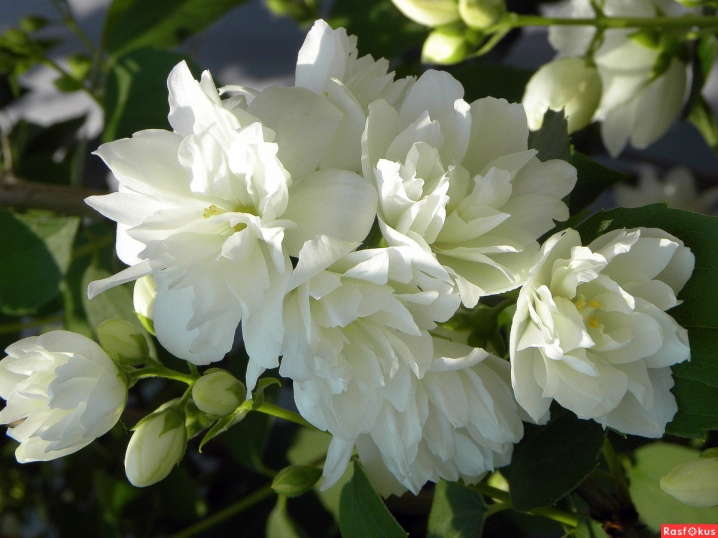
- "Bouquet blanche". It is considered not very frost-resistant, it belongs to undersized forms of a shrub with flowers of a spherical double shape. The inflorescence is formed from 5 buds tightly adjacent to each other. The dwarf bush forms plentiful shoots, has a lush crown. Due to freezing of the upper branches, flowering most often occurs on the lower branches.
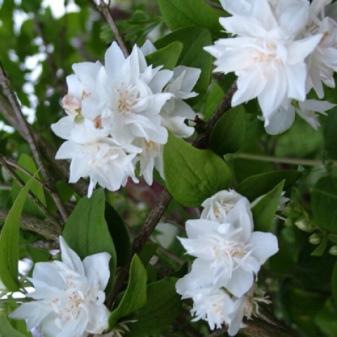
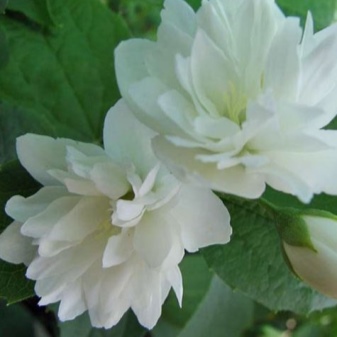
- Enchantement or "Charm". A dwarf variety with a height of no more than 1 m, belongs to the French selection group, is recognized as one of the most decorative and attractive. It is distinguished by lush branching of drooping annual shoots, the inflorescences consist of 9 buds, form brushes up to 7 cm long. The densely double flowers are rather large, the rosette reaches 4.5 cm.
The variety is distinguished by an exquisite, delicate aroma, late and not too long flowering.
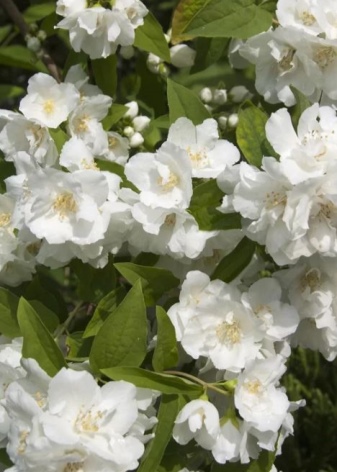
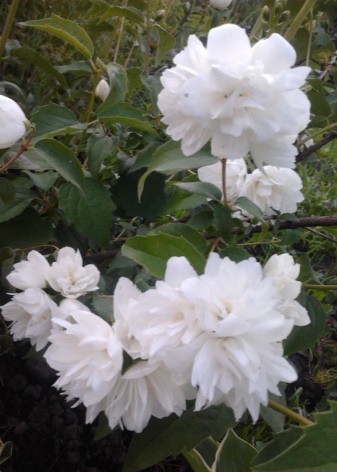
- Gletcher. French breeding variety of terry mock-orange, reaching 1.5-2 m in height, with straight stems, oval green leaves. During flowering, the bush is abundantly covered with dense and long brushes (up to 7 cm) of 5-7 flowers. The shade of the petals is white, the rosette is densely double, with a diameter of 4-4.5 cm, after flowering, pruning is recommended for the plant.
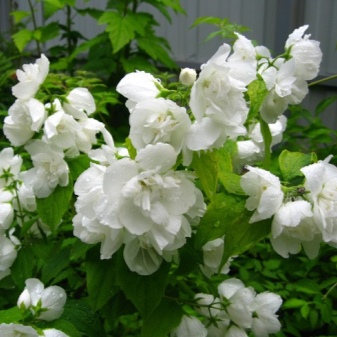
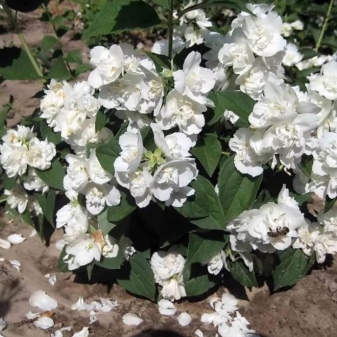
- Virginal. The very first selection terry variety. It forms a bush with a height of 2 to 3.5 m with a wide spreading crown. Deciduous plant changes the color of the leaves from green to yellow by autumn. The variety blooms in July, but can produce single clusters in early autumn again.
Flowers have a diameter of up to 5 cm, have a double structure of petals, inflorescences form brushes up to 14 cm long. The shrub retains its decorative effect for up to 20 years.
It differs in average winter hardiness, but in the middle lane it sometimes freezes up in especially harsh winters.
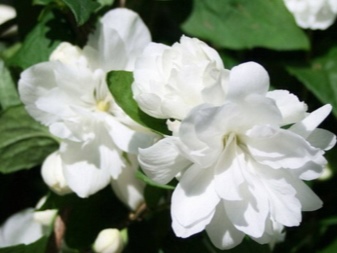
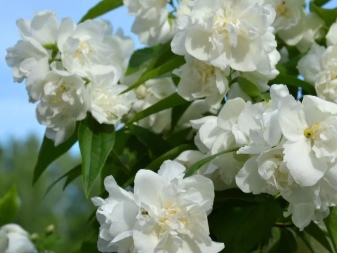
- "Ermine mantle". A dwarf variety that grows up to 80 cm in height. The plant is characterized by thin, cascading shoots in the manner of a cloak, the semi-double shape of a flower bowl. The rosette is not large, reaches 2.5-3 cm in diameter, 1-3 buds in the inflorescence, but they are formed very abundantly, so that the bush is almost completely covered with a lush white foam of flowers.
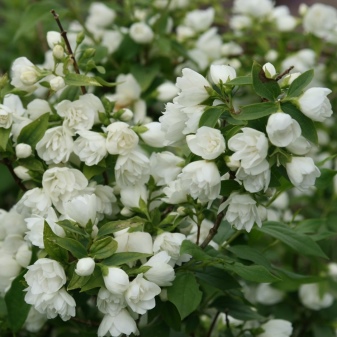
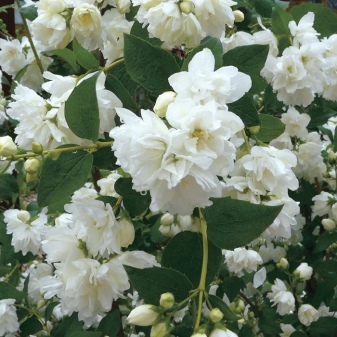
- "Moonlight". An exquisite variety with translucent, like glowing petals. The flowers are spherical, medium-sized, abundantly decorate the surface of the bush.
This type of hybrids is characterized by a bright, sophisticated aroma of strawberries.
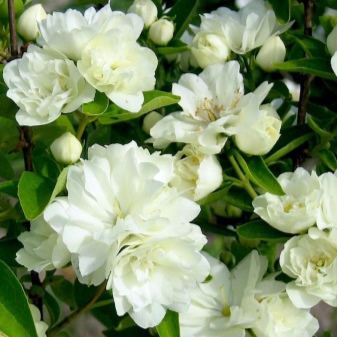
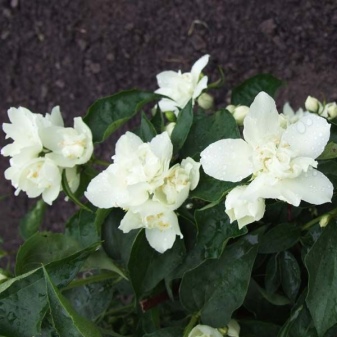
- "Blizzard". One of the most abundant flowering varieties. The shrub is low, up to 1.1 m, belongs to the group of terry mock-orange of domestic selection. The flowers literally cover the green foliage.
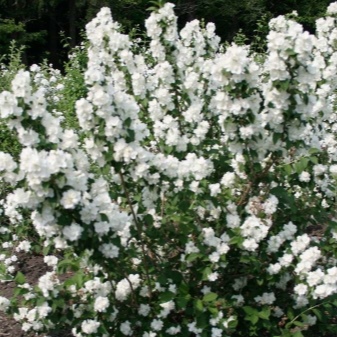
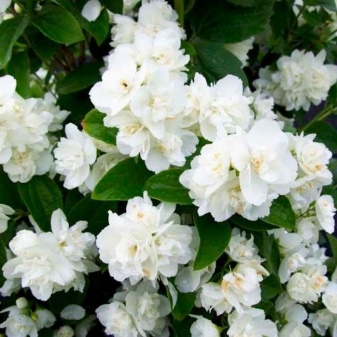
- "Yunnat". Luxurious densely doubled variety, perfect for the climate of the middle zone. The flowers are star-shaped, snow-white, the rosette reaches 4.5 cm in diameter. This variety is distinguished by long flowering, exquisite aroma of strawberries and vanilla.
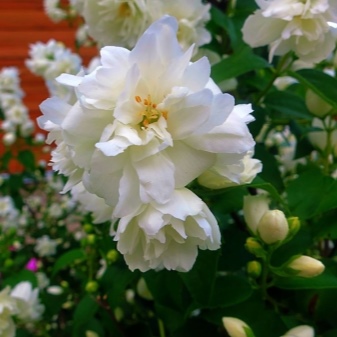
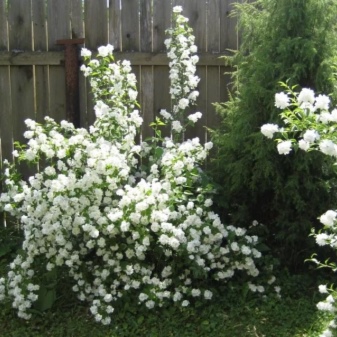
How to choose?
When choosing a variety of terry chubushnik, it is important to take into account its height, flowering time. It is worth paying attention to the fact that the shrub of Russian selection adapts better to the climatic conditions of the middle zone of the Russian Federation. French varieties, especially tall ones, often freeze slightly in the top area, after which they do not give flowers in this part of the crown. One of the best varieties is traditionally considered to be "Yunnat", "Snow storm" - unpretentious and very decorative.
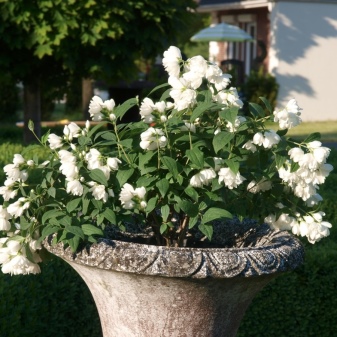
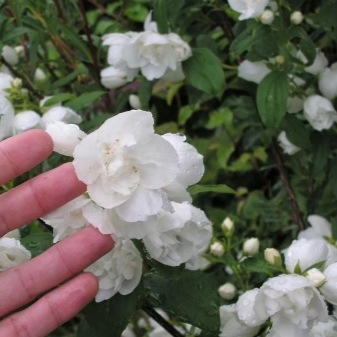
Landing
For planting a terry chubushnik, well-lit places on an area with rich and fertile soil are chosen. Nitroammofoska is poured into a prepared hole with a diameter of 60 cm, drainage is laid on the bottom, a soil mixture of compost, leaf humus and sand is mixed. The distance between the bushes of tall varieties is maintained up to 1.5 m, with dwarf forms - 0.8 m.
The landing procedure is as follows:
- part of the fertile soil is poured onto the bottom of the pit with drainage;
- a seedling is placed on top, holding it vertically;
- the plant is positioned, the root collar is located at the level of the edge of the hole;
- the remains of the soil are filled up;
- the surface is compacted;
- planting watered, mulch the ground at the roots.
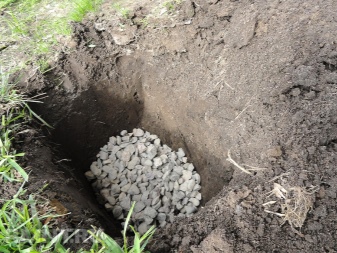


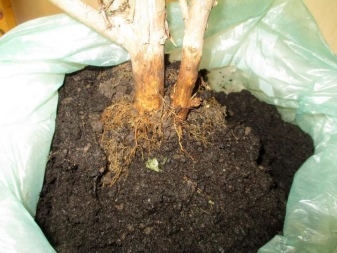
Follow-up care
The main care required for a terry chubushnik in the open field is weeding weeds, loosening the soil after watering. Besides, 3-4 times per season, the ground around the base of the bush is mulched with humus or dry fallen leaves.
For winter and spring, this procedure is repeated to create a comfortable microclimate around the roots.
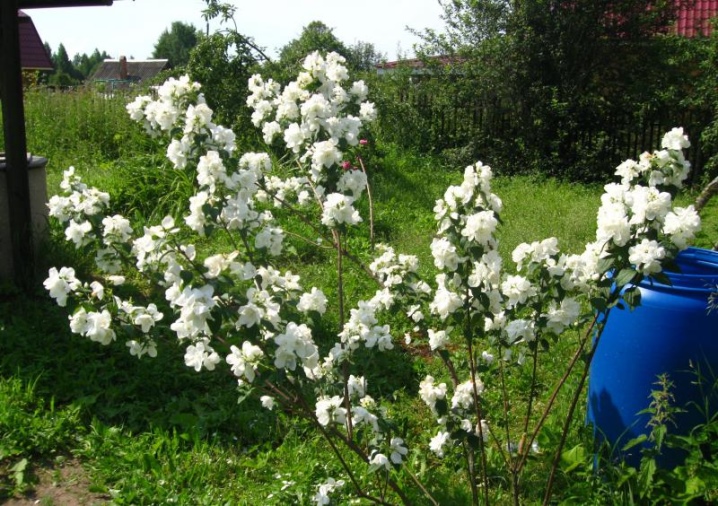
Watering
Frequent watering is not required for the plant. It is enough to add warm water under the root 2 times a week; in damp weather, you can do without this measure. At a time, 20-30 liters of water are introduced under the root, which will avoid waterlogging. Cold water should not be used for irrigation, as this can lead to a weakening of immunity, infectious infection.
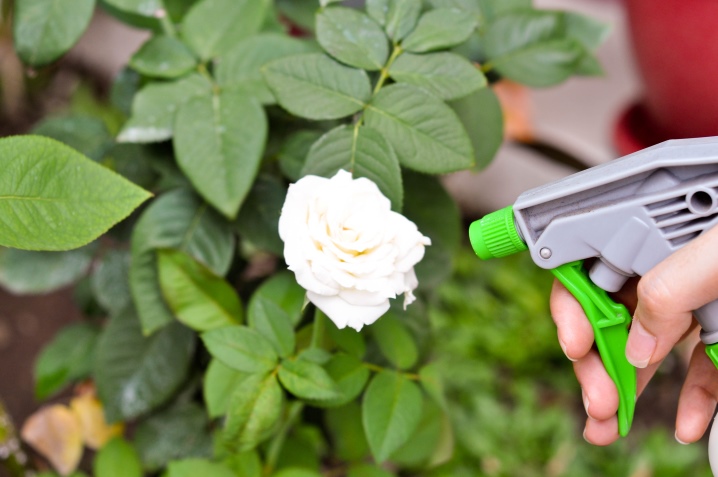
Top dressing
Fertilization of the soil is required for the plant, starting from 2 years from the moment of planting. Top dressing is performed 3 times a year. In the first stage, in the spring, a solution of slurry with water is introduced in a ratio of 1 to 10 under the root.
Before flowering, you need to provide replenishment with mineral fertilizers. - urea, superphosphate, potassium sulfate in the form of an aqueous solution of these substances in a volume of 7.5, 15 and 7.5 g per 10 l of liquid. At the end of summer, garden jasmine can be pleased with the introduction of dry fertilizers into the soil. A potassium-phosphate-based mineral complex will suffice.
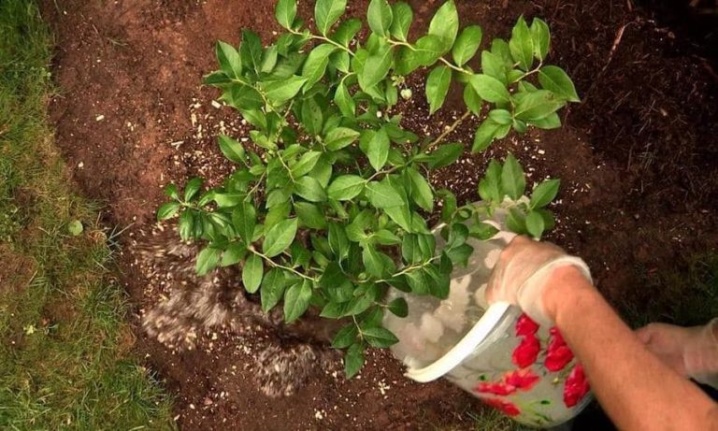
Pruning
Terry varieties of garden chubushnik are recommended to be pruned - both sanitary and form-building. It is carried out early, in spring, even before the start of sap flow. Long branches are shortened almost to the base, thin and weak - by 1/2 the length.
Young shoots are also left only partially: all, except for 2-3 of the strongest shoots, must be eliminated for the correct formation of the crown. From 3 years old, the bush will acquire regular and beautiful outlines in the spring.
Once every 5 years rejuvenating pruning almost to the root, no more than 4-5 cm of branches remain above the ground. Sanitary annual pruning is done in the spring. As part of the procedure, all dry and damaged branches are removed. In autumn and summer, it is recommended to cut off wilted inflorescences at the terry mock-orange.
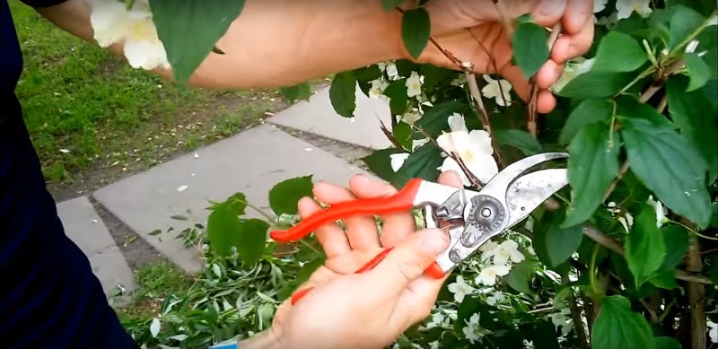
Preparing for winter
In temperate climates, garden jasmine does not need additional protection. In colder areas, the top of the bush may freeze, in the spring such shoots are removed. Saplings 1 year old need a mandatory shelter for the winter with burlap and twine tying the branches. The base of the bush is mulched with peat or humus.
In winter, you need to monitor the abundance of snow cover, remove it from the crown so that the shoots are not broken.

Disease and pest control
Terry chubushnik has a strong and strong immunity. The plant is practically not susceptible to disease. But insects are actively interested in them - weevil, spider mite, various types of aphids. The fight against them is carried out with the help of insecticidal agents, you can use a safe solution of laundry soap: the piece is dissolved in warm water, the crown is sprayed with the resulting composition in the spring.
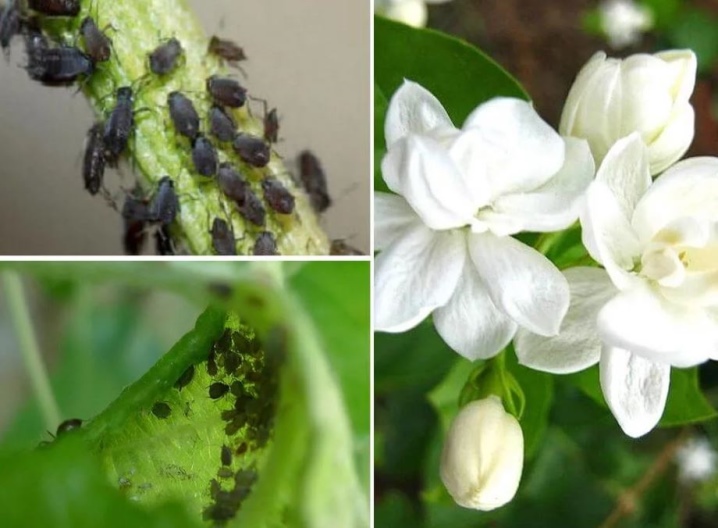
Breeding
You can easily propagate a terry mock on your own. The plant tolerates bush division well. After abundant watering, they dig it out, then cut it with a pruner into 3-4 parts. It is better to carry out the procedure in the fall, from the third decade of September.
You can propagate the terry chubushnik by cuttings in June. To do this, healthy shoots 10 cm long are cut obliquely from the plant. The cut is processed with a root formation stimulator - it is necessary to withstand the planting material in it for up to 12 hours.
Then the cuttings are sent to the greenhouse, in prepared containers with a nutrient substrate. Further, the seedlings should receive watering. The greenhouse is periodically ventilated. After rooting, the seedlings are gradually hardened, preparing for planting in the ground in a year.
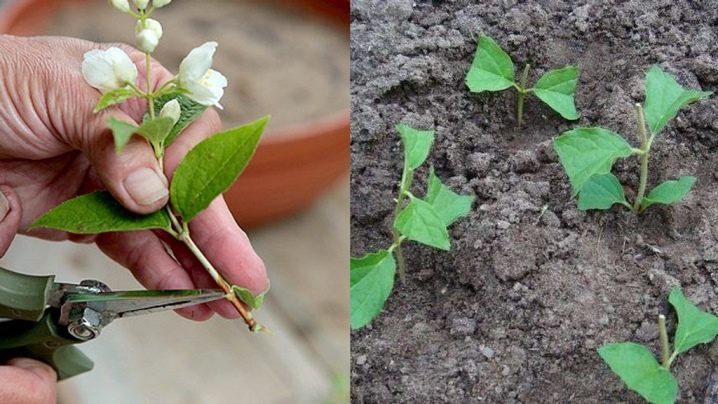
With seed reproduction, it will take at least 7 years to wait for the first flowering of the terry mock orange, and the hybrids will not retain their properties. It is easier to get a new plant through the creation of layering, digging in strong lateral shoots and hilling them 2 times per season. The separation of rooted bushes is carried out in the fall.
Beautiful examples in landscape design
Variety "Shneeshturm" beautifully sets off the space along the fence on the site.
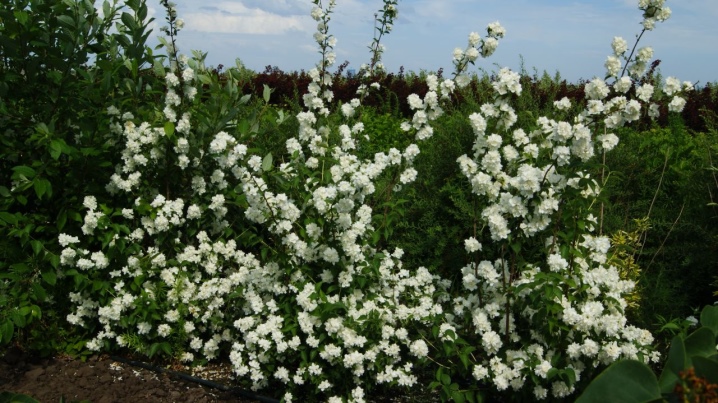
Lemoine's chubushnik with semi-double flowers is a true decoration of the garden landscape.
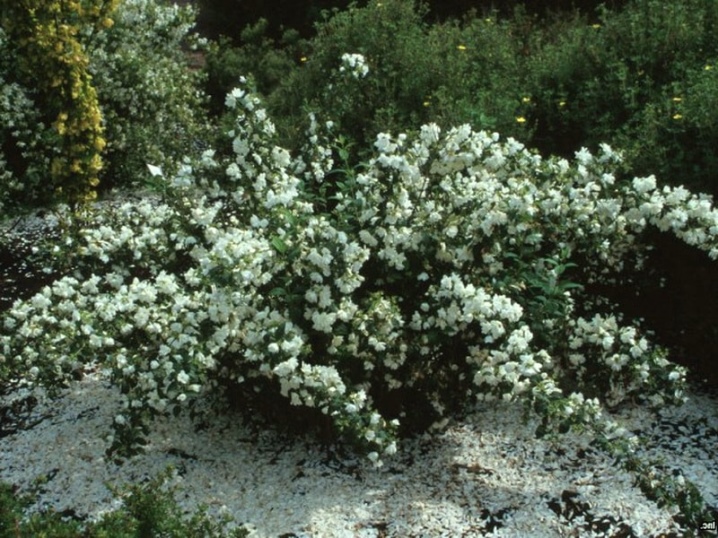
A lush bush of terry mock-orange will harmoniously set off the panoramic glazing of the facade, create an attractive view from the windows.
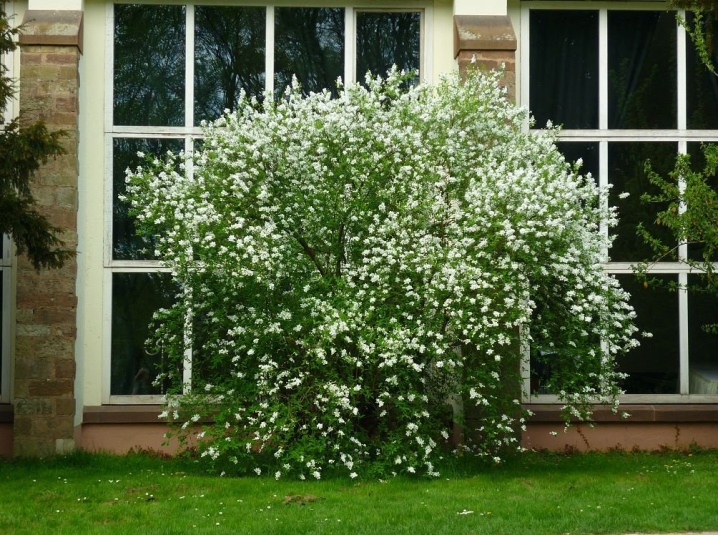
The following video will tell you how to properly care for a terry chubushnik.



































































The comment was sent successfully.